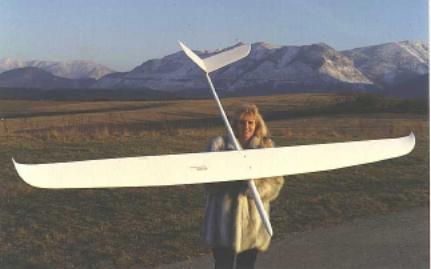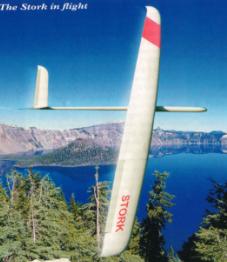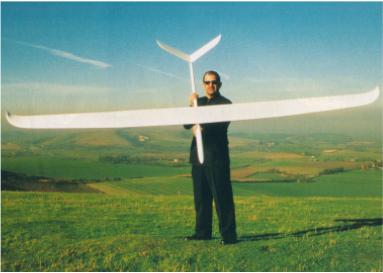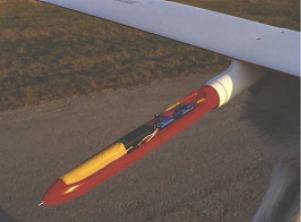| Heinrich
Stork/F3J, StorkII/F3J (available soon) |
|
|
|
Stork
|
StorkII
|
| Airfoil |
Wing
length |
3,400mm
|
3,230mm
|
| Wing
span |
-
|
-
|
| Profile |
SD7037
|
HN-354SM
|
| Wing
area |
67dm2
|
63.84dm2
|
| Wing
loading |
-
|
-
|
| Structure |
GRP/Rohacell
|
|
| Portability |
3
pieces
|
|
 |
Tail
plane |
Wing
Type |
V-Tail
|
|
| Wing
area |
7.64dm2
|
|
 |
| etc. |
Total
weight |
2300g(Ballast:+600g)
|
2,100g
|
| Radio
gear |
6
Servos, 7 Channels over
|
| Fuselage
Length |
1,520mm
|
|
|
The
wing of Stork sits on a pylon type mount which gives it good ground clearance
when flaps are down for landing. Though Stork has such a long wing as 3.4m,
total weight amounts to only 2.2kg. It seems that very skinny fuselage makes
Stork lighter. But it is not the reason. The Stork, unlike many molded planes,
is not overly heavy and one of ways it achieves this is to strike an excellent
balance between surface finish gloss and functionality; i.e. it has not
sprayed with masses of paint/gellcoat to get that deep gloss finish that
looks great but often very heavy. The Stork, is this design going to become
a classic?
Stork II/F3J will soon be available. Airfoil is HN-354. It became a little
smaller than classic Stork. |
 |
|
|
| There
are more comments on Stork
by Colin
Paddon Quoted from QFI38 |
 |
| Wing |
| The wing
is enough paint to give it a slight sheen almost as if it has been carefully
airbrushed all over, but no more. The wing joiners are rectangular shaped
solid carbon fiber bars that are very good fit in the wings without being
too tight a fit. Three kinds of wing joiners are available to give different
dihedral to assist its turning stability. But the joiner supplied as standard
might be enough.(Quoted from QFI38, Colin Paddon) |
 |
| Fuselage |
The Stork
has quite a long nose and looks as if it would need hardly any weight to
balance it. However 5 ounce lead must be added to the nose to get CG balance
point as specified in the instruction. The fuselage is very skinny in which
the servos, receiver and buttery fills the room in the nose completely.
The ballast are breached loaded, into a recess in the fuselage which in
uncovered when the nose cone is removed. The pushrods are preinstalled with
stainless steel tube running in the plastic outers.
A new set of instructions had been issued since he had picked up his Stork,
which now recommended a C of G and towhook position some 10mm in front of
the original instructions to better reflect "UK weather condition"
(Quoted from QFI38, Colin paddon) |
 |
| Flying... |
The maiden
flight of Stork by Colin paddon lasted only 12 senconds. There was the type
of silence from his colleagues that one finds disconcerting. It was not
until he had reassembled the model that the true cause for the incident
came to light. When he had picked up the Stork from Terry, he had passed
on all the required bolts. Under the closer examination, the main wing fixing
bolt he had used was too short by some 5mm, which was the same length as
that of tailplane. It was the reason of the downfall of his Stork. After
changing bolts for fixing main wing, he assembled the some of the original
crew at the first fateful attempt. Andrew saw fit to arrive wearing his
latest Gucci suit and posy sunglasses. This caused instant curiosity with
para gliding pilots and the public at large. When they arrived the airfield,
there was absolutely zero wind. They decided anyway to lauch the Stork as
it would be easy to do circuit and still get back easy. Mr. Gucci gave it
his best effort and the Stork slid effortlessly out from the hill. Twenty
five minutes later he was still flying, what on, who knows, it was so efficient
it was unnerving. The one good thing about there not being any wind is that
you can get to really feel out the control as if it were thermal flat field
flying and that's exactly what he did. This session only spurred him to
wanting to try the Stork in the environment for which it was designed, serious
thermal soaring.
Next day, he went to the slope. It really was windy, and believes him no
need for a pulley launch. Further flights confirmed that control/stability
on the line was excellent, once the wings were properly secured to the fuselage!
With the wings relaxed a little, it scoots along and penetrates surprisingly
well for a plane with a SD7037 wing section. The plan of the Stork is available
in this page for sure. |
 |



